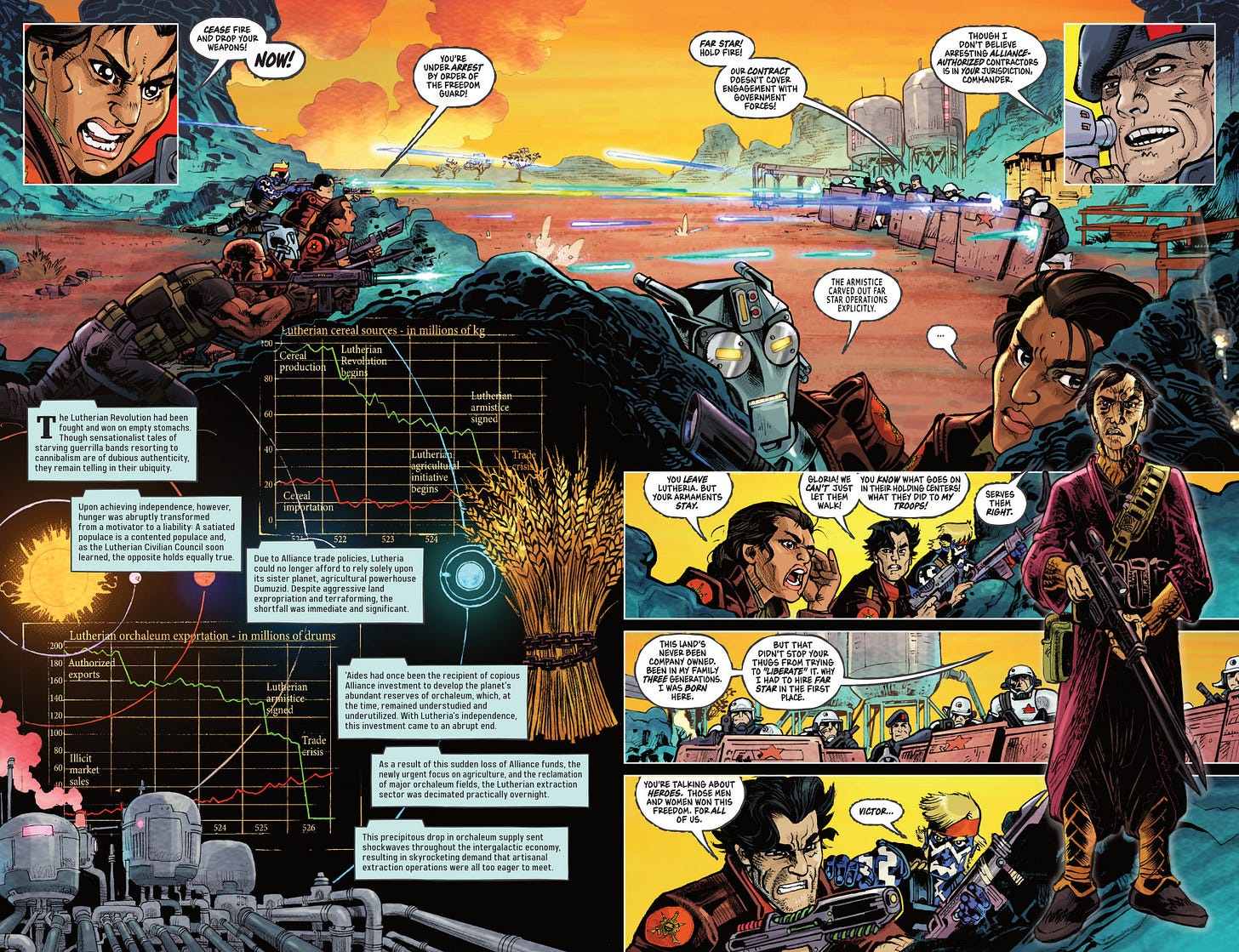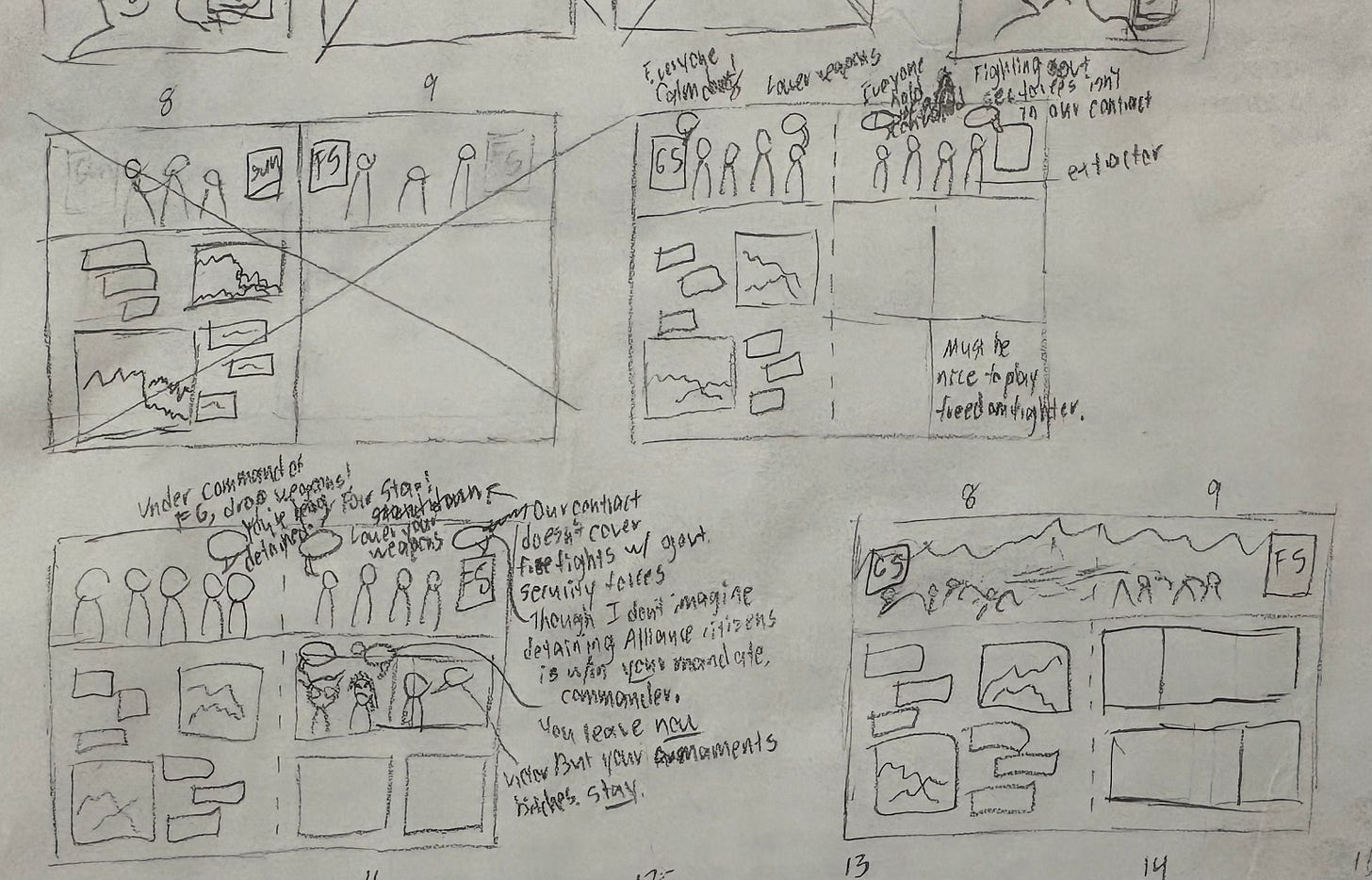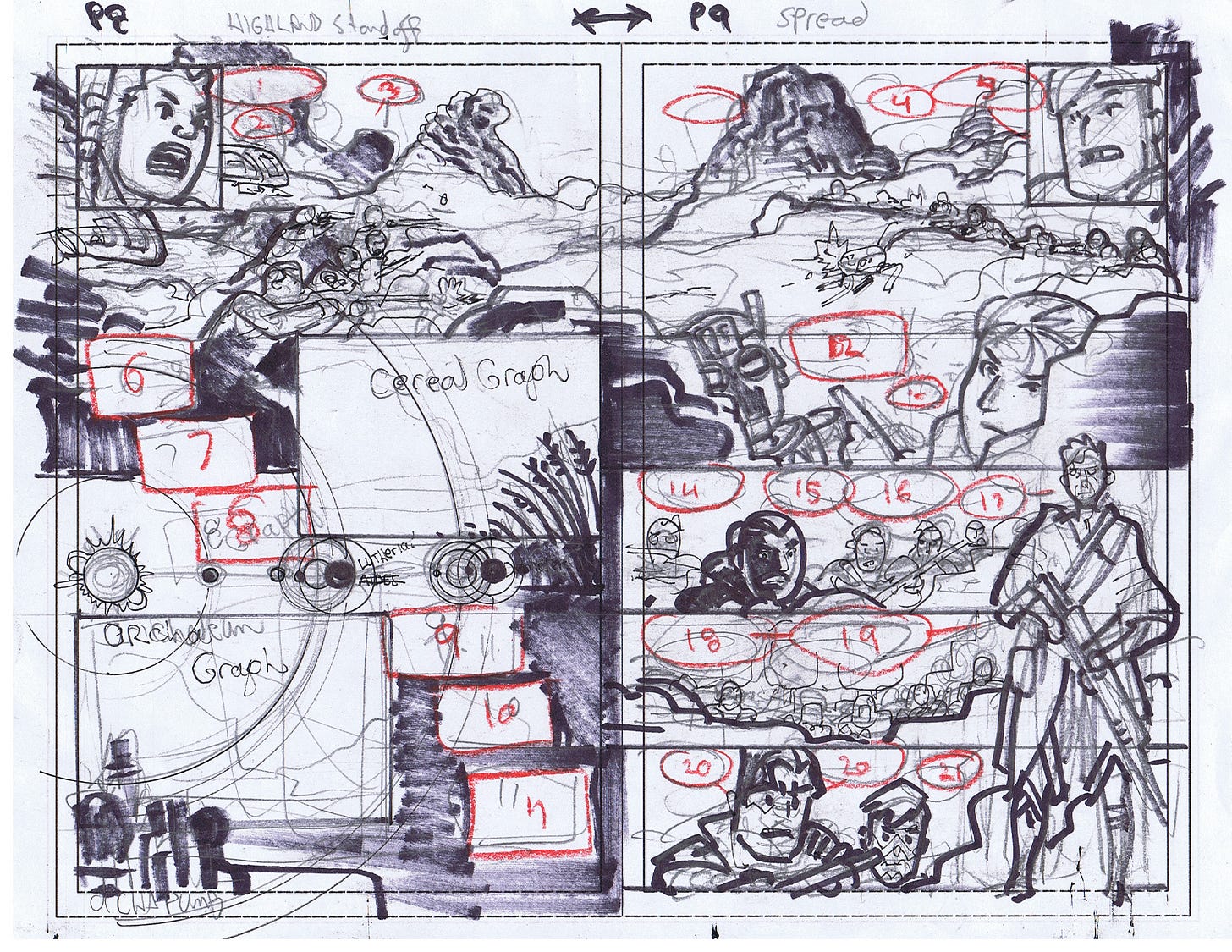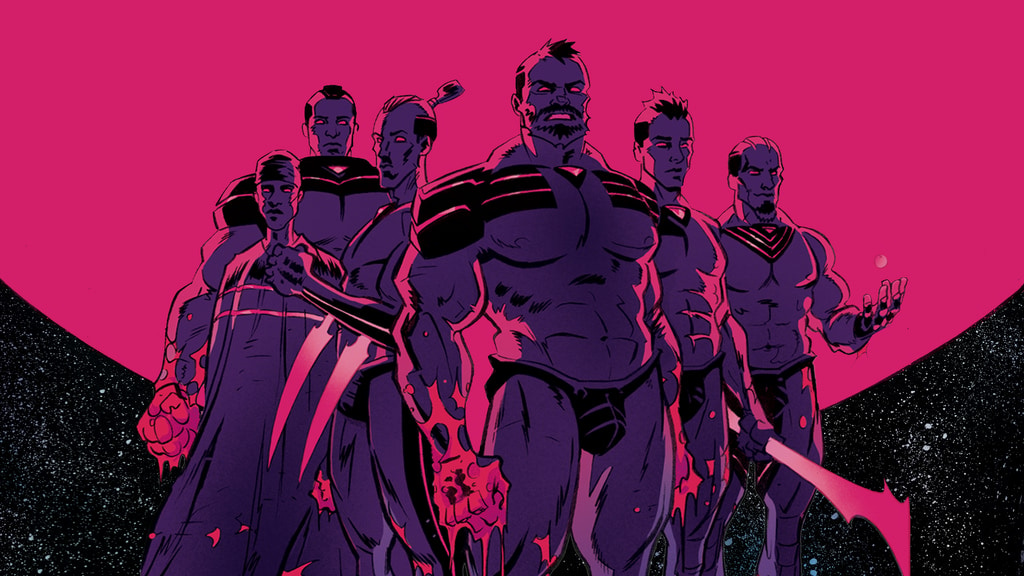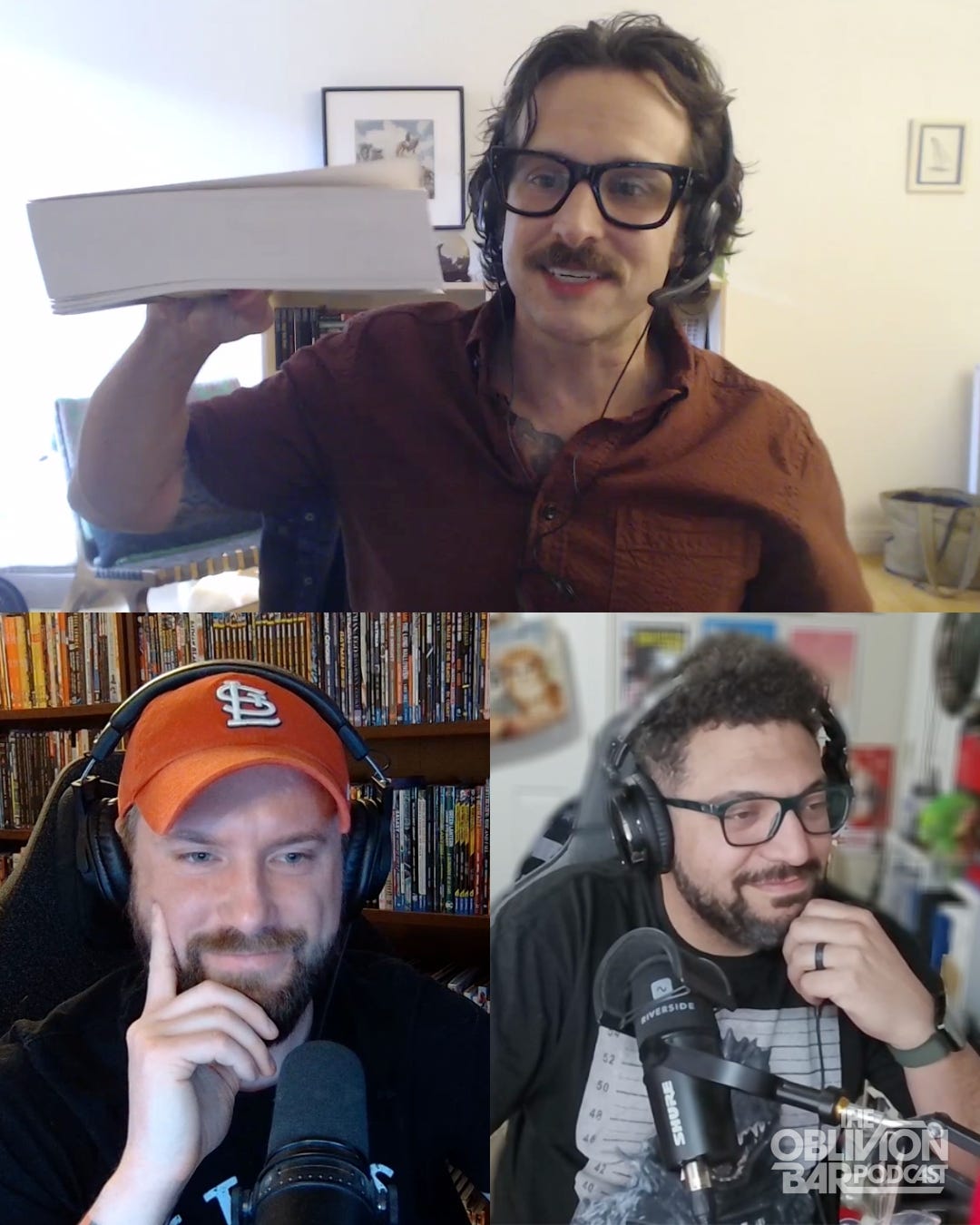The APPROACH
A never-before-seen Free Planet spread and a walkthrough of our unique approach to creating the Shape of Comics to Come
A step-by-step look at our process for creating one of Free Planet’s unbelievable spreads
A brand-new ERIS Kickstarter from my Brother-in-Beef Tyrell Cannon
Talking Free Planet’s unique approach and what inspired it with the boys from The Oblivion Bar
But first…
Final week to pre-order Free Planet
There are two extraordinarily compelling reasons to preorder and subscribe to Free Planet at your local comic shop:
It’s the only way to ensure you’ll get a copy of this in-demand comic. There’s been a lot of buzz about Free Planet and – if the going price for our ashcans is any indication – it will absolutely sell out.
It tells retailers that there’s demand and to order accordingly. Comic shops order books nonreturnable, which necessitates a risk-averse approach. Let them know it’s safe to order heavy on the Shape of Comics to Come.
You can find your local comic shop here or, if you’re not in driving distance of one, you can preorder signed copies from my friends at Collector’s Paradise. They and the inimitable Big Clutch also have extremely limited copies of the Buster Moody variant cover.
The APPROACH
What does it mean to be the Shape of Comics to Come? Free Planet has been designed – from the ground up – to function as literature and art object. The end result is something challenging, engrossing and utterly unique; there has never been a book like Free Planet.
Rather than developing a narrative and then parceling it out into issues, pages and panels, Free Planet prioritizes the rich display of visual information – often through spreads such as the one seen above – that readers are incentivized to explore for themselves. But to accomplish this, cocreator Jed Dougherty and I had to establish an entirely new mode of collaboration, comprising not only extensive research and design work, but a brand-new step for me as a writer: Thumbnails.
They’re not pretty or even terribly legible to someone who’s not me, but that’s beside the point. Getting out ahead of this: My thumbnails are never sent to Jed, who absolutely does not need them and always improves upon my ideas (as seen below). The reason for doing the thumbnails isn’t to control my cocreator but to ensure that I am always thinking visually.
Crucially, I do my thumbnails before I script. This is highly unusual; even writers who take the time to thumbnail typically do so after they’ve written a script. But while this is helpful to identify problems with scripts, it does nothing to ensure that each page is self-sufficient, a nigh-overwhelming presentation of visual information. By thumbnailing prior to scripting, I avoid pages that are merely functional, perfunctory connective tissue. Instead, every page of Free Planet fully utilizes comics’ foundational storytelling unit, the page, through a design- and layout-led presentation of narrative.
There’s no getting around it: Free Planet is a dense book. But rather than utilizing captions that function as ersatz thought balloons or descriptions of what’s already on the page, we charted a new course. Free Planet’s abundant captions provide additional information that allows readers to recontextualize their views of the story. This is accomplished through intricate worldbuilding that serves to elucidate, confirm or even undercut the action on the page.
Making all of that text work within our deliberate page layouts requires an artist of Jed’s immense talents. At the layout stage, Jed improves upon or completely replaces my layout ideas and determines the composition of individual panels with an acute awareness and consideration of captions and balloons. This ensures that everything not only fits properly, but is an essential and critical component of the overall page layout. Comics isn’t just pictures with text on top of them, but pictures and text working together to a singular, holistic, design-based end.
Charts and graphs are a popular flavor in comics these days. This is unsurprising given not only the colossal success of graph-friendly writers like Jonathan Hickman but the fact that graphs – as a marriage of text and image – are, at the very least, comics adjacent. In order to make sure that our graphs contribute to verisimilitude, luring people into the story instead of knocking them out of it, I plotted out individual data points, informed by extensive real-world research (food requirements by population size, fuel production, etc.) and painstaking discussions with my very patient high school economics teacher.
But while many comics use charts and graphs, we did something different: Free Planet includes all of its charts, graphs, infographics, maps and diagrams in the comic itself. This grants us two distinct benefits. First, it lowers the risk of readers simply skipping over them. Second, and most significantly, it allows for thematic interplay, such as in this scene, in which a reader’s immediate reaction to the Freedom Guard’s actions is recontextualized by a deeper understanding of Lutheria’s dire economic realities.
But again: All of this planning and advance work would be for naught if not for Jed’s prodigious talents. With the page laid out, granular graph making complete and textual elements locked in, it’s finally time for Jed to switch into another aspect of his awe-inspiring brilliance: Draftsmanship. One of the many things that is truly remarkable about Jed is the fact that he never skimps or gives half effort. Naturally, all Jed’s details are aligned with our thematic concerns, furthering our twin goals of creating literature as well as an art object.
Once the inks are complete, the Free Planet process largely resembles standard US direct market comic book production. There is, however, one major exception: we give extensive notes on coloring and lettering, in order that they are aligned and working in concert with each page’s thematic thrust. I was lamenting to novelist Jonathan Lethem what a micromanager I am and he stopped me, “Nono, you’re an auteur.” I told him, “Sure, that sounds better!” Look forward to future newsletters, which will explore the specific and enormous strengths and contributions of my long-time lettering collaborator Taylor Esposito and first-but-definitely-not-last-time color collaborator Vittorio Astone.
Go back ERIS right now
BLUF: Go back Tyrell Cannon’s Kickstarter for ERIS: The Complete Collection. Long-time readers will know all about Tyrell, my Brother-in-Beef and cocreator of the instant classic populist superheroes BEEF BROS. But whether you snagged that book or not, if you’re reading Atlantis still sunk, I know that you’re going to flip for ERIS.
As you can tell from the image above, ERIS leans heavily into 80s/90s action movie aesthetics, to which I say: Righteous. But writing off Tyrell and his brother Logan’s psychedelic epic as mere muscleman power fantasy would be a horrific mistake. ERIS’ presentation of stunning visuals and horrific violence is in the service of the type of complexity that can only be achieved by comics. If any of my comics theorizing has struck a chord with you, you must go back ERIS: The Complete Collection immediately.
I stop by The Oblivion Bar
This past weekend, I had the pleasure of talking with Chris and Aaron on The Oblivion Bar podcast. Chatting with two folks who have so eagerly engaged with Free Planet’s complexity was a fantastic way to spend a Sunday afternoon; they asked incredibly insightful questions about the APPROACH, what informed it (leading to me showing off some of my reading material above), the bile that fuels it, and more.
Of specific interest to me – and a reason I’ll likely be bothering both Chris and Aaron in the future – are the boys’ military backgrounds. Free Planet is a military-focused book, with my research into real-world revolutions driving me to conduct focused interviews with service members of all levels. It’s enormously gratifying to know that veterans find Free Planet respectful, honest and compelling.
For those of you who have made it to the end, it bears repeating: It’s utterly crucial that you pre-order Free Planet. Charting out the Shape of Comics to Come isn’t without risk; Free Planet is a big swing for the entire creative team and, as mentioned above, there’s nothing else like it on the racks. Because of that uniqueness, it can be difficult for comic shops to order properly, which, combined with the already surging demand for this thing, could result in the tragedy of you not being able to get your hands on Free Planet #1.
So…Find your local comic shop and give them a ring before April 14 or pre-order the first six from Collector’s Paradise. Whatever you do: Make sure you get in on the ground floor of Free Planet.
NEXT WEEK: We’re digging back into Free Planet’s extensive bibliography; weigh in below on what you’d like me to discuss next.
Aubrey


